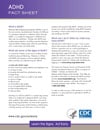Facts About ADHD

ADHD is one of the most common neurobehavioraldisorders of childhood. It is usually first diagnosed in childhood and often lasts into adulthood. Children with ADHD may have trouble paying attention, controlling impulsive behaviors (may act without thinking about what the result will be), or be overly active.[1]
Signs and Symptoms
It is normal for children to have trouble focusing and behaving at one time or another. However, children with ADHD do not just grow out of these behaviors. The symptoms continue and can cause difficulty at school, at home, or with friends.
A child with ADHD might:

- have a hard time paying attention
- daydream a lot
- not seem to listen
- be easily distracted from schoolwork or play
- forget things
- be in constant motion or unable to stay seated
- squirm or fidget
- talk too much
- not be able to play quietly
- act and speak without thinking
- have trouble taking turns
- interrupt others
Types
There are three different types of ADHD, depending on which symptoms are strongest in the individual:
- Predominantly Inattentive Type: It is hard for the individual to organize or finish a task, to pay attention to details, or to follow instructions or conversations. The person is easily distracted or forgets details of daily routines.
- Predominantly Hyperactive-Impulsive Type: The person fidgets and talks a lot. It is hard to sit still for long (e.g., for a meal or while doing homework). Smaller children may run, jump or climb constantly. The individual feels restless and has trouble with impulsivity. Someone who is impulsive may interrupt others a lot, grab things from people, or speak at inappropriate times. It is hard for the person to wait their turn or listen to directions. A person with impulsiveness may have more accidents and injuries than others.
- Combined Type: Symptoms of the above two types are equally present in the person.
Causes of ADHD
Scientists are studying cause(s) and risk factors in an effort to find better ways to manage and reduce the chances of a person having ADHD. The cause(s) and risk factors for ADHD are unknown, but current research shows that genetics plays an important role. Recent studies of twins link genes with ADHD.1
 In addition to genetics, scientists are studying other possible causes and risk factors including:
In addition to genetics, scientists are studying other possible causes and risk factors including:- Brain injury
- Environmental exposures (e.g., lead)
- Alcohol and tobacco use during pregnancy
- Premature delivery
- Low birth weight
Research does not support the popularly held views that ADHD is caused by eating too much sugar, watching too much television, parenting, or social and environmental factors such as poverty or family chaos. Of course, many things, including these, might make symptoms worse, especially in certain people. But the evidence is not strong enough to conclude that they are the main causes of ADHD.
For more information about cause(s) and risk factors, visit the National Resource Center on ADHD or the National Institute of Mental Health
or the National Institute of Mental Health .
.
Diagnosis
Deciding if a child has ADHD is a several step process. There is no single test to diagnose ADHD, and many other problems, like anxiety, depression, and certain types of learning disabilities, can have similar symptoms. One step of the process involves having a medical exam, including hearing and vision tests, to rule out other problems with symptoms like ADHD. Another part of the process may include a checklist for rating ADHD symptoms and taking a history of the child from parents, teachers, and sometimes, the child.
Treatments

In most cases, ADHD is best treated with a combination of medication and behavior therapy. No single treatment is the answer for every child and good treatment plans will include close monitoring, follow-ups and any changes needed along the way.
Get Help!
If you or your doctor has concerns about ADHD, you can take your child to a specialist such as a child psychologist or developmental pediatrician, or you can contact your local early intervention agency (for children under 3) or public school (for children 3 and older).
The Centers for Disease Control and Prevention (CDC) sponsors theNational Resource Center , a program of CHADD – Children and Adults with Attention-Deficit/Hyperactivity Disorder. Their Web site has links to information for people with ADHD and their families. The National Resources Center operates a call center with trained staff to answer questions about ADHD. The number is 1-800-233-4050.
, a program of CHADD – Children and Adults with Attention-Deficit/Hyperactivity Disorder. Their Web site has links to information for people with ADHD and their families. The National Resources Center operates a call center with trained staff to answer questions about ADHD. The number is 1-800-233-4050.
To find out who to speak to in your area, you can contact the National Dissemination Center for Children with Disabilities by logging on to http://www.nichcy.org/ or calling 1-800-695-0285.
or calling 1-800-695-0285.
In order to make sure your child reaches his or her full potential, it is very important to get help for ADHD as early as possible.

No comments:
Post a Comment